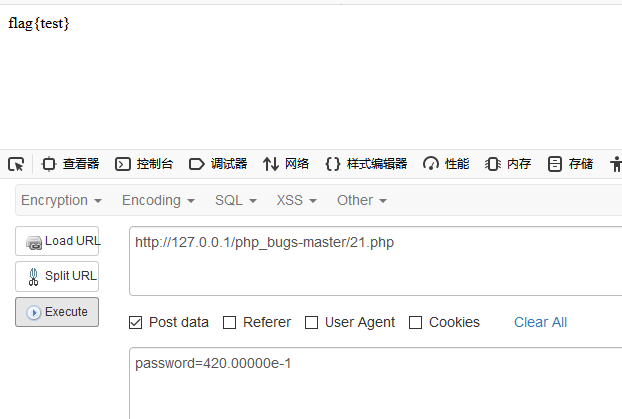20 十六进制与数字比较
源代码为:
<?php
error_reporting(0);
function noother_says_correct($temp)
{
$flag = 'flag{test}';
$one = ord('1'); //ord — 返回字符的 ASCII 码值
$nine = ord('9'); //ord — 返回字符的 ASCII 码值
$number = '3735929054';
// Check all the input characters!
for ($i = 0; $i < strlen($number); $i++)
{
// Disallow all the digits!
$digit = ord($temp{$i});
if ( ($digit >= $one) && ($digit <= $nine) )
{
// Aha, digit not allowed!
return "flase";
}
}
if($number == $temp)
return $flag;
}
$temp = $_GET['password'];
echo noother_says_correct($temp);
?>GET方式传入password的值,输出经过noother_says_correct函数处理之后的值。
noother_says_correct函数处理的逻辑为:先对password中的每一位进行判断,若在1--9之间,则直接返回false,若都满足,并且$number = '3735929054',$number==$password,则返回flag。
我们很容易能够注意到:
$number == $temp这里两个等号,是弱类型比较,即会先将比较的两者类型进行转化后再比较,在计算机中0x开头的表示为十六进制,所以我们可以使用十六进制来绕过前面的for循环,同时满足等于temp
3735929054转换成十六进制后为:deadc0de
加上0x后为0xdeadc0de,可以看出可以逃逸出for循环中的限制,所以最后的payload为:
?password=0xdeadc0de
21 数字验证正则绕过
<?php
error_reporting(0);
$flag = 'flag{test}';
if ("POST" == $_SERVER['REQUEST_METHOD'])
{
$password = $_POST['password'];
if (0 >= preg_match('/^[[:graph:]]{12,}$/', $password)) //preg_match — 执行一个正则表达式匹配
{
echo 'Wrong Format';
exit;
}
while (TRUE)
{
$reg = '/([[:punct:]]+|[[:digit:]]+|[[:upper:]]+|[[:lower:]]+)/';
if (6 > preg_match_all($reg, $password, $arr))
break;
$c = 0;
$ps = array('punct', 'digit', 'upper', 'lower'); //[[:punct:]] 任何标点符号 [[:digit:]] 任何数字 [[:upper:]] 任何大写字母 [[:lower:]] 任何小写字母
foreach ($ps as $pt)
{
if (preg_match("/[[:$pt:]]+/", $password))
$c += 1;
}
if ($c < 3) break;
//>=3,必须包含四种类型三种与三种以上
if ("42" == $password) echo $flag;
else echo 'Wrong password';
exit;
}
}
?>这里用到了PHP正则表达式,简单列举一下字符串类的正则表达式:
[[:alpha:]] :匹配任何字母
[[:digit:]] :匹配任何数字
[[:alnum:]] :匹配任何字母和数字
[[:space:]] :匹配任何空白字符
[[:upper:]] :匹配任何大写字母
[[:lower:]] :匹配任何小写字母
[[:punct:]] :匹配任何标点符号
[[:xdigit:]] :匹配任何16进制数字,相当于[0-9a-fA-F]
[[:blank:]] :匹配空格和Tab,等价于[\t]
[[:cntrl:]] :匹配所有ASCII 0到31之间的控制符
[[:graph:]] :匹配所有的可打印字符,等价于[^ \t\n\r\f\v]
[[:print:]] :匹配所有的可打印字符和空格,等价于[^\t\n\r\f\v]使用POST方式传输password
if ("POST" == $_SERVER['REQUEST_METHOD'])
{
$password = $_POST['password'];第一个if中正则表达式匹配所有的可打印字符,并且需要大于等于12个
if (0 >= preg_match('/^[[:graph:]]{12,}$/', $password)) //preg_match — 执行一个正则表达式匹配
{
echo 'Wrong Format';
exit;
}然后是一个while循环
第二个 if 里面,使用 preg_match_all
$reg = '/([[:punct:]]+|[[:digit:]]+|[[:upper:]]+|[[:lower:]]+)/';按照这个规则(标点符号;数字;大写字母;小写字母),将password至少分为6段
例如:abc123+a1? 就可以分为:abc 123 + a 1 ? 这6段
第三个 if 中,使用 for 循环判断 password 中是否存在 标点符号,数字,大写字母,小写字母中的至少三种
$c = 0;
$ps = array('punct', 'digit', 'upper', 'lower'); //[[:punct:]] 任何标点符号 [[:digit:]] 任何数字 [[:upper:]] 任何大写字母 [[:lower:]] 任何小写字母
foreach ($ps as $pt)
{
if (preg_match("/[[:$pt:]]+/", $password))
$c += 1;
}
if ($c < 3) break;最后想要获得 flag ,还需要令传入的password=="42"
if ("42" == $password) echo $flag;从最后的相等出发,因为是弱类型比较,我们首先想到的是十六进制或者科学计数法。
在科学计数法中,有:https://www.php.net/manual/en/language.operators.comparison.php
其中
var_dump(0 == "a"); // 0 == 0 -> true
var_dump("1" == "01"); // 1 == 1 -> true
var_dump("10" == "1e1"); // 10 == 10 -> true
var_dump(100 == "1e2"); // 100 == 100 -> true所以我们可以有 4.2e1==42,也可以有420e-1==42,当然还可以继续如0.42e2==42
为了多一个减号,我们采用420e-1,再变形为:420.0e-1,满足password分成六段的要求,接着满足长度大于等于12的要求,变形为:420.00000e-1
POST传输:

参考链接:
http://bayescafe.com/php/yuebaomei-ctf.html
来源:oschina
链接:https://my.oschina.net/u/4302796/blog/4479646